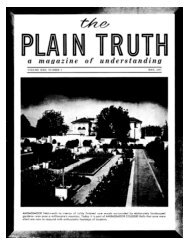The Biblical Basis of the Sacred Calendar Part One
The Biblical Basis of the Sacred Calendar Part One
The Biblical Basis of the Sacred Calendar Part One
Create successful ePaper yourself
Turn your PDF publications into a flip-book with our unique Google optimized e-Paper software.
matters. So God gave <strong>the</strong> heavenly "signs" (lunar and solar eclipses): things man can see which point to<br />
something he cannot see (that is, God's design behind <strong>the</strong> heavenly cycles).<br />
Thus we can know when <strong>the</strong> rosh chodesh (in Psalm 81:3, simply chodesh) falls in <strong>the</strong> sacred calendar.<br />
All else being equal, it is <strong>the</strong> day on which <strong>the</strong> molad (not <strong>the</strong> new crescent) falls. But all else is not equal<br />
all <strong>the</strong> time! That is why <strong>the</strong>re are postponements to <strong>the</strong> date <strong>of</strong> Tishri 1 (to which <strong>the</strong> dates <strong>of</strong> all <strong>the</strong> o<strong>the</strong>r<br />
calendrical "new moons" are adjusted). We will return to <strong>the</strong>se in due time.<br />
* "Appointed times" translates mo`adim (singular mo`ed). <strong>The</strong> word signifies a time specifically set or<br />
appointed by a person or circumstance. Translators differ as to <strong>the</strong> significance <strong>of</strong> mo`ed in Genesis 1:14<br />
because <strong>the</strong>y do not accept <strong>the</strong> simplest explanation <strong>of</strong> all <strong>the</strong> relevant facts.<br />
We know that "He made <strong>the</strong> moon for appointed times [mo`adim]", in contrast to <strong>the</strong> sun which<br />
determines <strong>the</strong> beginning and ending <strong>of</strong> <strong>the</strong> day (Psalm 104:19, literal translation). We also know that<br />
mo`ed may be connected with <strong>the</strong> seasons <strong>of</strong> <strong>the</strong> solar year (Genesis 18:10, 14, in which "<strong>the</strong> time <strong>of</strong> life"<br />
means <strong>the</strong> spring season - cf. RSV; see also Leviticus 23:1-4). In Genesis 1:14, <strong>the</strong>n, <strong>the</strong> "appointed<br />
times", like <strong>the</strong> "signs" with which <strong>the</strong>y are linked, are events determined by both <strong>the</strong> moon and <strong>the</strong> sun,<br />
this time by <strong>the</strong> lunar phase cycles in combination with <strong>the</strong> solar seasons.<br />
This correlation <strong>of</strong> <strong>the</strong> months with <strong>the</strong> seasons is directly responsible for <strong>the</strong> 19-year cycle <strong>of</strong> <strong>the</strong> Hebrew<br />
and certain o<strong>the</strong>r calendars. (Nineteen solar [tropical] years equal almost exactly 235 lunar [synodic]<br />
months.) This alignment, coupled with <strong>the</strong> biblical commands regarding <strong>the</strong> timing <strong>of</strong> Passover and<br />
Tabernacles, is also <strong>the</strong> reason why <strong>the</strong>re are seven intercalary or "leap" years inserted among twelve<br />
common years in <strong>the</strong> 19-year cycle. <strong>The</strong>se numbers seven and twelve are significant, in <strong>the</strong> light <strong>of</strong> <strong>the</strong>ir<br />
importance in <strong>the</strong> Bible. <strong>The</strong>y point to <strong>the</strong> completeness and perfect organization <strong>of</strong> <strong>the</strong> calendar.<br />
<strong>The</strong> relevant biblical commands are found in Deuteronomy 16:1 (with parallel verses in Exodus, Leviticus<br />
and Numbers); Exodus 23:16; and Exodus 34:22. According to Deuteronomy 16:1 and its parallels,<br />
Passover must fall in <strong>the</strong> first month <strong>of</strong> spring - that is, "in <strong>the</strong> month <strong>of</strong> Abib [green ears or buds]". <strong>The</strong><br />
ripening <strong>of</strong> early barley and <strong>the</strong> appearance <strong>of</strong> new buds on trees is closely linked to <strong>the</strong> timing <strong>of</strong> <strong>the</strong><br />
spring equinox. A lunar month in which <strong>the</strong> spring equinox falls after <strong>the</strong> calendar date <strong>of</strong> <strong>the</strong> full moon<br />
(<strong>the</strong> 15th <strong>of</strong> <strong>the</strong> month) cannot be "<strong>the</strong> month <strong>of</strong> Abib". When such a circumstance occurs, <strong>the</strong> following<br />
full lunar month is to be reckoned as <strong>the</strong> first month <strong>of</strong> <strong>the</strong> sacred year (cf. Exodus 12:1-2).15<br />
<strong>The</strong> following simple table illustrates <strong>the</strong> relationship between "<strong>the</strong> month <strong>of</strong> Abib" and <strong>the</strong> spring equinox:<br />
Notice that in our received calendar (as based on rules <strong>of</strong> calculation first published in extant sources by<br />
Hillel II16 ), "<strong>the</strong> month <strong>of</strong> Abib" is not always <strong>the</strong> month in which <strong>the</strong> spring equinox occurs. In <strong>the</strong> first<br />
illustrated sequence, <strong>the</strong> 15th day <strong>of</strong> <strong>the</strong> lunar month (in principle, <strong>the</strong> calendar day <strong>of</strong> <strong>the</strong> mean full moon)<br />
in which <strong>the</strong> equinox occurs falls after (but not too far after) <strong>the</strong> spring equinox; yet it is <strong>the</strong> following<br />
month which is "<strong>the</strong> month <strong>of</strong> Abib". (In this case, <strong>the</strong> year is a leap year, for reasons that will be<br />
explained below.) In <strong>the</strong> second, <strong>the</strong> 15th <strong>of</strong> <strong>the</strong> lunar month falls a little later, relative to <strong>the</strong> spring<br />
equinox. This month is, unquestionably, "<strong>the</strong> month <strong>of</strong> Abib". In <strong>the</strong> third sequence, <strong>the</strong> spring equinox<br />
occurs well after <strong>the</strong> 15th day <strong>of</strong> <strong>the</strong> lunar month in which it falls.17 In this latter case, once again, <strong>the</strong>
















